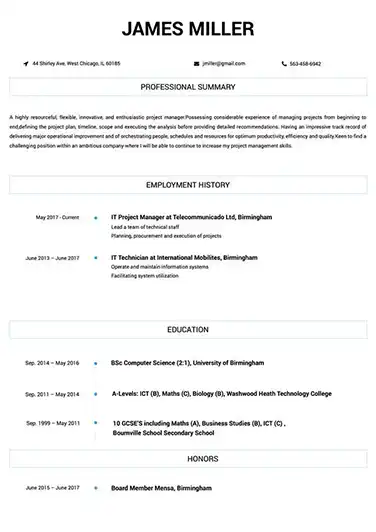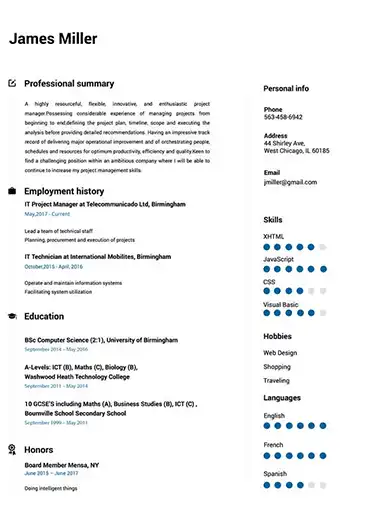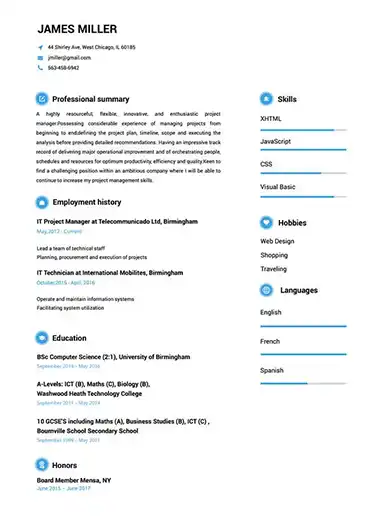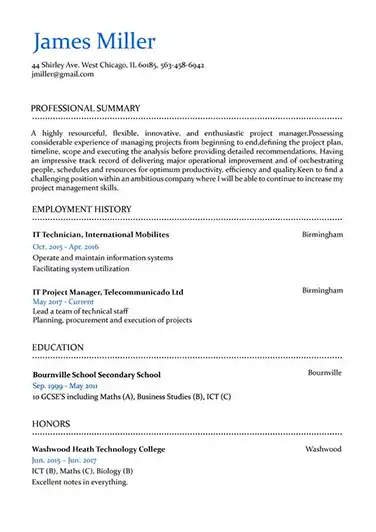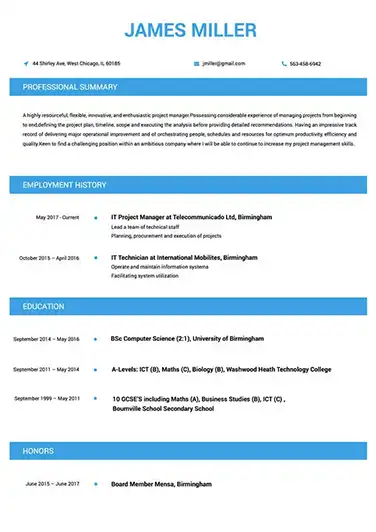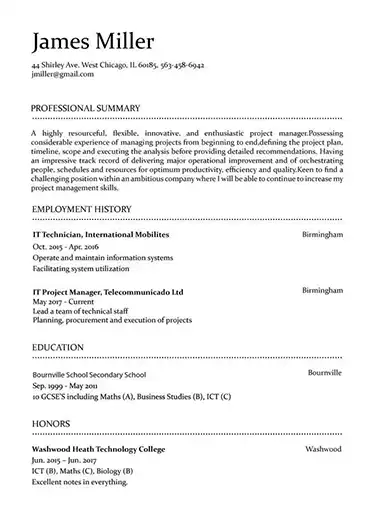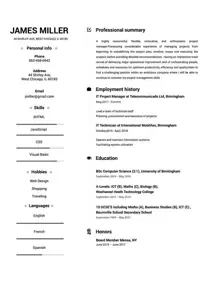 Use This Template
Use This Template
Build your resume in 15 minutes
Create an awesome resume that meets the expectations of potential employers with our selection of professional, field-tested resume templates.
architect: Resume Samples & Writing Guide
stanley-allen@mail.com
852-762-0366
Employment history
- Preparing architectural drawings and documents
- Reviewing shop drawings and material samples
- Staying up-to-date with the latest building technologies and materials
- Designing plans and specifications for building projects
- Preparing architectural drawings and documents
- Meeting with clients to discuss project requirements
- Meeting with clients to discuss project requirements
- Estimating project costs and providing cost analysis
- Developing detailed construction schedules
Education
Skills
Do you already have a resume? Use our PDF converter and edit your resume.
ursanelson@inbox.com
607-950-7959
Employment history
- Providing technical advice and guidance to clients
- Coordinating with contractors, engineers, and other professionals
- Designing plans and specifications for building projects
- Coordinating with contractors, engineers, and other professionals
- Designing plans and specifications for building projects
- Reviewing shop drawings and material samples
- Conducting site visits and inspections
- Developing detailed construction schedules
- Participating in professional organizations and continuing education programs
Education
Skills
leonardsmith96@aol.com
933-958-8591
Employment history
- Monitoring construction progress and ensuring compliance with building codes and regulations
- Developing detailed construction schedules
- Providing technical advice and guidance to clients
- Coordinating with contractors, engineers, and other professionals
- Resolving design and construction problems
- Monitoring construction progress and ensuring compliance with building codes and regulations
- Estimating project costs and providing cost analysis
- Staying up-to-date with the latest building technologies and materials
- Meeting with clients to discuss project requirements
Education
Skills
edwards_hal@hotmail.com
687-708-7628
Professional Summary
Employment history
- Ensuring projects are completed on time and within budget
- Resolving design and construction problems
- Estimating project costs and providing cost analysis
- Meeting with clients to discuss project requirements
- Conducting site visits and inspections
- Staying up-to-date with the latest building technologies and materials
- Developing detailed construction schedules
- Resolving design and construction problems
- Estimating project costs and providing cost analysis
Education
Skills
ulrich-young@hotmail.com
772-785-0391
Professional Summary
Employment history
- Designing plans and specifications for building projects
- Staying up-to-date with the latest building technologies and materials
- Developing and maintaining relationships with clients
- Meeting with clients to discuss project requirements
- Developing and maintaining relationships with clients
- Reviewing shop drawings and material samples
- Preparing architectural drawings and documents
- Reviewing shop drawings and material samples
- Coordinating with contractors, engineers, and other professionals
Education
Skills
Not in love with this template? Browse our full library of resume templates
Award-winning architect Norman Foster once said, “As an architect you design for the present, with an awareness of the past, for a future which is essentially unknown.” This poetically articulates the mastery that the world’s best architects rely on to design the buildings and other structures that surround us.
If you’re looking to make your own mark in the industry and keep working your way up, you should take comfort in the fact that the Bureau of Labor Statistics projects employment of architects will grow by 8 percent from 2018 to 2028.
But don’t let this positive projection make you complacent in your job search! Architecture is still one of the most competitive industries to progress in, particularly at more prestigious architecture firms.
What’s more, the truth of the matter is that many - if not most - architects aren’t engaged in the types of projects they dream about. Instead of designing the next Petronas Towers or The Shard, they’re working on uninspiring constructions that won’t be featured in ArchDaily anytime soon.
If this sounds eerily familiar, it’s time to get working on your resume. Once you have a strong architect resume to apply with, your chances of getting your dream job will increase tenfold. To help you put together one recruiters will rush to read, we’ve outlined the most important guidelines and expert tips to keep in mind.
In this architect resume guide, you’ll discover:
- What constitutes a great architect resume
- How to correctly showcase your educational background
- Which skills you need to highlight (including examples from real-life job ads)
- Expert tips for making your achievements shine
- A speedy way to make an incredible architect resume
1. Multiple Template Examples
2. How to Write an Architect Resume That Will Land You the Job
How to format it
Ensuring your resume features the optimal resume format is as crucial as perfecting the words within it. Just like you wouldn’t present a client with a messy mockup of your latest building - you also shouldn’t present recruiters with a resume that’s all over the place.
Without a doubt, a reverse chronological format is the best format for your architect resume. The reason we suggest using this format is because it highlights all of the work you’ve put in to get to where you are today. When a recruiter sees your resume, they’ll be able to immediately see all of the tremendous strides you’ve made in your career. This will, in turn, help them envision you making even more strides in the role they’re hiring for.
It’s also crucial to keep some resume layout rules in mind. We’ve shared the most fundamental ones for an architect resume below:
- Number of Pages: Your resume must only be one page.
- Fonts to Use: Any that can easily be read at first glance, such as Constantia and
- Corbel.
- Fonts to Avoid: Any that may be misinterpreted due to how intricate they are, such as Zaphino and French Script.
- Margins: 1 inch on all sides.
- Line Spacing: 1 or 1.15.
- Header size: 14-16 point size.
- Text size: 11-12 point size
What makes a great architect resume?
While many candidates settle on creating a resume that’s ‘good enough,’ you need to set a higher standard for your own one if you want to snag your dream job.
If you’re wondering what makes a great architect resume, it boils down to two defining features: being well-formatted and well-written. In other words, the best resumes boast both looks and substance. By following our formatting recommendations above, and the expert tips we’ve shared throughout this guide, you’ll be able to create a resume that truly impresses.
That being said, there isn’t a one-size-fits-all answer to the question, “What makes a great architect resume?” After all, every recruiter’s interpretation of a “great” resume is different. No two jobs nor recruiters are the same, so you’ll be shooting yourself in the foot by applying with the same resume to multiple jobs.
So there is one more feature you need to keep in mind in order to make a great architect resume: customization. As we discuss more extensively further below, targeting your resume for each application by customizing the contents of it will ensure that you address the specific criteria a recruiter is after.
How to give recruiters what they’re looking for
Recruiters are looking for architects that have an ideal blend of educational qualifications, soft and hard skills, and professional experiences. You can give them what they’re looking for by highlighting relevant and eye-catching information about each of these attributes in your resume.
Remember, your resume is like a blueprint for why you’re the perfect candidate. So in order to convince them of this fact, you’ll need to ensure your resume provides a proper outline as well as evidence of your suitability for the role at hand.
How to prepare for a job interview as an architect
No matter how many times you’ve done them, job interviews are always a very intimidating experience. As you may know from experience, the more prepared you are, the better your chances will be for passing it.
Careful preparation will allow you to both calm your nerves and ensure you’re ready to answer even the most trickiest of interview questions. If you really want to ace your interview, consider the following 5 expert tips:
- Practice answering standard interview questions: Do yourself a favor and practice answering common architect interview questions in the weeks and days leading up to your interview. There are countless resources online that provide questions to practice with, such as this one from The Architect’s Guide.
- Re-familiarize yourself with the job ad: Chances are that quite a bit of time has passed since you applied and you received the good news about your interview. That’s why it’s vital to re-familiarize yourself with the job ad. It provides the biggest hints as to what the recruiter is looking for and will ask you about, so it’s bound to help you in your pre-interview preparations.
- Conduct a deep dive research into the company: In addition to asking you about your professional experiences, it’s almost a guarantee the interviewer will quiz you about their company. It’s therefore essential to research some key stats about the company. Some common questions they may ask could relate to when the company was established, who their clients are, what their most notable achievements are, what their company goals are, who is on the executive team, and so on.
- Practice nerve-calming techniques: Pre-interview jitters get the best of all of us. Fortunately, there are plenty of simple anxiety-reducing breathing techniques and meditations that you can practice that will help you refocus and give you the best chance of succeeding.
- Plan your trip in advance: Don’t leave working out your travel route to the last minute. Plan how you’ll get to the interview and factor in the chance of delays and other complications. While you should only head into the reception area 10 to 15 minutes earlier than your scheduled appointment, aim to arrive at your destination at least 30 minutes before.
How to highlight your most important achievements
If there’s one thing your resume should do, it’s make your achievements shine like the Eiffel Tower at night. So what’s the best way to highlight your most important achievements on your resume? We’ve created a 3-step guide that we suggest you follow:
- Work out which achievements you should include in the first place: Don’t make the mistake of featuring your proudest achievements. You need to select achievements a recruiter would find eye-grabbing. To do this, scan the job ad for keywords that reveal what a recruiter is looking for from their ideal candidate. Create a list of these keywords.
- Match up your achievements with the keywords: Consult the list of keywords. Ask yourself, “Which ones relate to my work experiences in my current and previous roles?” Mark the keywords that apply to your achievements.
- Write out each achievement with the relevant keyword included: Now you can flesh out your achievements, based on each relevant keyword it relates to. It’s important to incorporate the keyword as naturally as possible into your achievement. That means that if it sounds like you jammed the keyword into your achievement, you’ll need to rewrite it until it flows.
You should aim to make your achievement sound as impressive as possible by not only stating what the achievement is, but also the positive effect it had on the given company.
For example, if you’re targeting the keyword “prepare design proposals,” your achievement should look something like this:
- Regularly prepare design proposals based on client’s goals, aesthetic, and budget, resulting in a 400% increase in client onboardings since I joined.
This achievement does everything our 3-step guide outlines. It effectively focuses the achievement around the keyword and naturally incorporates it in. Moreover, it sounds impressive, because the candidate states both: what the achievement is (“Regularly prepare design proposals based on client’s goals, aesthetic, and budget”) and how it had a positive impact on the company (“...a 400% increase in client onboardings since I joined”). These two features make for a winning achievement in our books!
Which soft and hard skills should you mention and how to do it correctly?
The skills you choose to highlight in your resume can make or break your application. If you don’t feature the skills a recruiter is prioritizing, your application will come to a crashing halt.
In order to pinpoint what these skills are, you need to take another look at the keywords the recruiter has included in the job ad. Focus on finding keywords related to the skills an architect will need to excel in the role.
You will quickly notice that architect skills can be split into two types: soft and hard skills.
1. Soft skills
Soft skills describe any interpersonal skills that rely on a candidate’s people skills, communication skills, or other non-tangible abilities.
Below are some examples of top soft skills architects need to have that we’ve taken from real-life job ads:
- Presentation skills
- Oral communication skills
- Written communication skills
- Ability to develop client relations
- Motivation
- Ability to be self directed
- Proactiveness
- Collaborative working skills
- Analytical thinking
- Attention to detail
2. Hard skills
Hard skills describe any technical skills candidates should have that are practical and measurable.
Below are some examples of top hard skills architects need to have that we’ve taken from real-life job ads:
- SketchUp proficiency
- ArchiCAD Essential proficiency
- Revit proficiency
- AutoCAD proficiency
- Architectural rendering
- Understanding of construction documentation
- Preparing design proposals
- Producing detailed drawings
- Negotiating with contractors
So how do you correctly include your hard and soft skills in your resume? Firstly, you should pick 6 to 8 of them to star in a special “Skills” section on your resume. Be sure to list them rather than write them out in sentence form. You should also mention the most relevant skills you offer throughout your achievements section. It’s also advisable to include a few in your resume objective or summary as well.
Pro tip: Try your best to use the same wording the recruiter has used for each keyword, as doing so will help your resume get past Applicant Tracking System (ATS). This is a recruitment tool that analyzes if your resume should get the tick of approval, based on whether it includes certain keywords. That being said, your resume should also make sense to humans, so it’s best to modify the wording, if it doesn’t make sense to keep it as-is.
How to list your education correctly
Architects are some of the most highly educated professionals around. As the Bureau of Statistics states, the typical first step you must take to become an architect is to graduate from a 5-year Bachelor of Architecture. You can then choose to go on to a master’s degree, which can take anywhere from 1 to 5 years to complete.
In order to list your education correctly on your resume, you must create an “Education” section.
You should ensure you avoid sharing too many details about your studies or writing in complete sentences, like this candidate did:
Education
- I have a Bachelor of Architecture from the University of Arkansas and am currently completing my Master of Design Studies at the same university. I am completing my Master’s degree so I can one day secure a leadership position in an architecture firm.
Instead, provide a list of your degree/s in reverse-chronological order (i.e. starting at your current or most recent degree). Only include key details such as:
- The degree name
- The name of the educational institution
- The years you were/are studying
Let’s now rewrite the above candidate’s education using this format:
Education
- 2020 - Present Master of Design Studies, University of Arkansas
- 2014 - 2019 Bachelor of Architecture, University of Arkansas
See how much cleaner and sharper that formatting looks? If the candidate still wants to mention their leadership aspirations, they can mention them in their resume objective instead.
How to write a resume objective or summary and examples of both
A resume objective or resume summary should eloquently communicate to a recruiter in 2 to 4 sentences why they should see you as a serious contender for the job. Both of these sections have the potential to significantly transform a recruiter’s impression of you.
But it’s only necessary to include one of them in your resume. If you’re an entry-level candidate, a resume objective will best serve your needs, whereas experience architects should opt for a resume summary. Keep reading to discover how to expertly craft each one to perfection:
Resume objective
As an entry-level candidate, it can feel like your lack of experience will always be a constant barrier standing in your way. Rest assured that this won’t be the case for long if you can write a convincing resume objective.
In order to do so, you’ll need to ensure that you don’t make some common writing pitfalls like the following candidate did:
- Aspiring architect who’s currently studying architecture in college. I’ve only completed one internship, but I’m looking to gain some proper paid work experience at Woods & Johns Architecture Studio.
This candidate’s resume objective is undesirable for a number of reasons. First of all, they haven't provided any insightful details about themselves. This would make it difficult for a recruiter to form a connection with them.
What’s more, they emphasize their inexperience and the fact that they’re after a paid position. These points are both unnecessary to explicitly mention because not only is it already understood that entry-level candidates lack professional experience, but it’s also extremely taboo to bring up the topic of salary in your resume. One final mistake the candidate makes is that they’ve focused on their own needs instead of those of Woods & Johns Architecture Studio.
Let’s now look at an example of a well-written resume objective:
- Aspiring architect who’s currently studying a Bachelor of Architecture at California Polytechnic State University (3.6 GPA). After completing a 6-month internship at Prism Architectures where I received a glowing letter of recommendation from the managing director (attached), I am now seeking to apply my enthusiasm for architecture as well as my superior sketching skills to Woods & Johns Architecture Studio.
This candidate’s resume objective is 100 times better than that of the previous candidate. They’ve provided a detailed, but not overly-wordy overview of themselves and why they’re an excellent candidate for the position.
Moreover, they’ve expertly addressed the qualities the recruiter is looking for in their ideal candidate by highlighting their education, internship experience, relevant hard and soft skills, and enthusiasm. As if that wasn’t already impressive enough, they seamlessly conveyed what an asset they would be if they were hired by Woods & Johns Architecture Studio by mentioning the letter of recommendation they received.
Resume summary
Once you’ve been working for a couple of years as an architect you should switch to using a resume summary. The reason being that a resume summary will help you keep progressing in your career by making it clear to a recruiter how you’ll smoothly transition into the position they’re hiring for.
Given how important a resume summary is, you should work on it so it doesn’t read as poorly as this candidate’s summary does:
- Experienced architect currently working at a good architecture firm wants a full-time position at Mirage Architects. I aim to learn everything I can from all of the talented architects there so I can one day head my very own architecture firm.
As far as the recruiter is concerned, this candidate’s resume objective is completely forgettable as it would just blend in with those of most other candidates. That’s because they failed to provide any specific and relevant details that are unique and eye-catching.
Another mistake the candidate made is that they framed the opportunity to work at Mirage Architects as just another step towards their ultimate goal - heading up their own architecture firm. While it’s fine to mention career goals, they should always be connected to the company you’re applying for.
Now that you know what to avoid, let’s see what a fantastic resume summary looks like:
- Architect with 5 years of experience currently working in one of the country’s top architecture firms is seeking a full-time position at Mirage Architects. I aim to use my
out of the box thinking and problem solving strategies as well as my award-winning 3D design skills to attract new high-profile clients to the company.
If you can put as much effort into writing your resume summary as this candidate did, you can expect to receive a lot of job offers. The reason this candidate’s resume summary would strike a chord with the recruiter is because it really sells their suitability for the job. They convey that they can offer exactly what the recruiter is after: strong work experience, useful hard and soft skills, and drive.
The candidate has even mentioned that they won awards for their work, which would certainly spark a recruiter’s interest in them. Last but not least, the candidate makes it clear how they aim to use their skills and experiences to make a positive contribution to Mirage Architects. There isn’t any more that a recruiter could ask for in a resume summary!
How to target your resume for each application
If there’s one task every recruiter for architects has on their resume checklist - it’s to ascertain whether a candidate has targeted their resume for the application. Recruiters don’t want to just hire highly-skilled architects who would be happy to work anywhere - they want to hire highly-skilled architects who are determined to work at their company.
The easiest way to show your eagerness to work in a particular role as well as your suitability to excel in it is to target your resume for each application. Yes, that means that you can no longer send the same resume to every architecture firm!
You need to get into the habit of modifying your resume each time you apply for a new job. This will ensure your resume addresses the specific criteria that each unique firm is looking for. As we previously discussed, it all comes down to naturally incorporating the keywords the recruiter has used in a job ad throughout relevant sections of your resume.
The strategy of using keywords from a job ad to select the most relevant skills and achievements to feature in your resume is the most effective way you can target your resume for each application. If you follow this strategy, you’ll be able to make it crystal clear to the recruiter that you represent everything they’ve been searching for.
How to make your resume stand out
You’ll be happy to learn that making your resume stand out isn’t nearly as complex as the design configurations for the Burj Khalifa. All it requires you to do is go the extra mile to catch a recruiter’s eye. If you want to learn how to do this, follow our top recommendations below:
- Skip gaudy resume templates: It can be tempting to use a flashy resume template with different colors, funky fonts, and eye-catching patterns to get a recruiter’s attention. After all, you want to show off your eye for design, right? Keep in mind that if your resume has too many design features, it will both distract the recruiter and cause the ATS difficulties when rendering your resume. Your best bet is to stick to using a simple but professional-looking resume template.
- Include a link to your portfolio: Your architect portfolio showcases your very best work. So it makes sense to link to it in your resume. Doing so will give recruiters the opportunity to see your skills, design approach, and talent with their very own eyes. You can add a link to your professional website, profile on your current company’s page, and/or your Behance portfolio in the “Contact Information” section of your resume. And what should you do if you don’t yet have an online portfolio? We suggest you get working on it!
- Look for opportunities to upskill: It may mean it’s time for you to upskill if you’re gunning for a particular job, but fall short of what the recruiter is looking for. After all, the only way to gain the skills you lack is to start developing them. Consider asking for extra training in your current workplace, enrolling in an online course, or getting your masters. Remember, the more skills you have at your disposal, the more you’ll be able to match recruiters’ expectations.
3. How to Make a Professional Resume in Just Minutes Using Resumebuild.com’s Resume Builder Tool
We know that you can accurately sketch a building you just saw with your eyes closed. But how do you think you’d fare following our resume guide above?
We’ve tried to explain all of the tips, tricks, and steps for making a stunning architect resume as clearly as possible. But at the end of the day, making a resume by yourself is a laborious task. Moreover, even if you try your best to follow our guide to a tee, your resume may still fall flat.
That’s why we want to share an alternative method that’s guaranteed to help you achieve far better results. Introducing Resumebuild.com’s resume builder tool. We designed this online resume builder to help job seekers like yourself to speedily create an attractive architect resume that recruiters will be desperate to read.
Forget about wasting time remembering all of our expert tips or worrying that you’ve broken this or that rule. Our resume builder is designed to guide you through all the steps you need to take to craft an ideal resume.
You’ll find it a breeze to input the information needed to complete each resume section. If you’re stuck for ideas about what to include or how to word certain sections, our pre-written examples will help you out. Ready to begin right away? Get started at Resumebuild.com.
architect Job Descriptions; Explained
If you're applying for an architect position, it's important to tailor your resume to the specific job requirements in order to differentiate yourself from other candidates. Including accurate and relevant information that directly aligns with the job description can greatly increase your chances of securing an interview with potential employers.
When crafting your resume, be sure to use action verbs and a clear, concise format to highlight your relevant skills and experience. Remember, the job description is your first opportunity to make an impression on recruiters, so pay close attention to the details and make sure you're presenting yourself in the best possible light.
architect
- Design and prepare furniture drawings
- Led initiatives to formulate product strategy, deliver industry-leading backup and recovery features, and superior performance at scales of thousands of databases
- FMU Building( Function mockup Interface)
- Manage the coordination and overall integration of technical activities in architecture or engineering projects.
architect
- Prepare preliminary design drawings and Perspective views for Hospitality projects.
- Conduct design review and evaluation with design team and revise the design based on input from client and attend site meeting as necessary.
- Co-ordination with Structural, Electrical and Plumbing disciplines
- Prepare documents to form the design documentation and working drawing package.
- Worked on Site with construction team and other disciplines.
- Review Mockups, Samples & Submittals.
architect (internship)
- Drafted mockups and submitted them for review.
- Crafted detailed drawings that met customer requirements.
- Consulted with clients to determine functional and spatial requirements of new structure.
- Created, printed and modified drawings in AutoCAD
architect
- Preparation of architectural plans, elevations, sections, and detail sheets.
- Preparing and presenting design proposals, including detailed drawings of finished buildings, renovations, or restorations.
- Creating detailed drawings and specifications for architectural projects.
- Working with computer-aided design software to create blueprints and images.
architect
- Produce detailed drawings
- Design various Buildings (Exterior & Interior) and Landscapes.
- Visualize and illustrate proposals in 2D and 3D to clients
- Prepare and present design proposals to clients.
- Advise clients, review plans, propose changes.
architect Job Skills
For an architect position, your job skills are a key factor in demonstrating your value to the company and showing recruiters that you're the ight fit for the role. It's important to be specific when highlighting your skills and ensure that they are directly aligned with the job requirements, as this can greatly improve your chances of being hired. By showcasing your relevant skills and experience, you can make a compelling case for why you're the best candidate for the job.
How to include technical skills in your resume:
Technical skills are a set of specialized abilities and knowledge required to perform a particular job
effectively. Some examples of technical skills are data analysis, project management, software proficiency,
and programming languages, to name a few.
Add the technical skills that will get hired in your career
field with our simple-to-use resume builder. Select your desired resume template, once you reach the skills
section of the builder, manually write in the skill or simply click on "Add more skills". This will
automatically generate the best skills for your career field, choose your skill level, and hit "Save &
Next."
- CAD
- BIM
- Structural Design
- Construction Management
- Cost Estimation
- Building Codes
- Building Materials
- Site Supervision
- Blueprint Reading
- Construction Scheduling
- Project Management
- Quality Control
- Safety Regulations
- Building Systems
- Construction Safety
- Contract Administration
- Construction Drawings
- Building Inspections
- Construction Cost
- Site Planning.
How to include soft skills in your resume:
Soft skills are non-technical skills that relate to how you work and that can be used in any job. Including
soft skills such as time management, creative thinking, teamwork, and conflict resolution demonstrate your
problem-solving abilities and show that you navigate challenges and changes in the workplace
efficiently.
Add competitive soft skills to make your resume stand-out to recruiters! Simply select
your preferred resume template in the skills section, enter the skills manually or use the "Add more skills"
option. Our resume builder will generate the most relevant soft skills for your career path. Choose your
proficiency level for each skill, and then click "Save & Next" to proceed to the next section.
- Communication
- Interpersonal
- Leadership
- Time Management
- Problem Solving
- Decision Making
- Critical Thinking
- Creativity
- Adaptability
- Teamwork
- Organization
- Planning
- Public Speaking
- Negotiation
- Conflict Resolution
- Research
- Analytical
- Attention to Detail
- Self-Motivation
- Stress Management
- Collaboration
- Coaching
- Mentoring
- Listening
- Networking
- Strategic Thinking
- Negotiation
- Emotional Intelligence
- Adaptability
- Flexibility
- Reliability
- Professionalism
- Computer Literacy
- Technical
- Data Analysis
- Project Management
- Customer Service
- Presentation
- Written Communication
- Social Media
- Troubleshooting
- Quality Assurance
- Collaboration
- Supervisory
- Risk Management
- Database Management
- Training
- Innovation
- Documentation
- Accounting
- Financial Management
- Visualization
- Reporting
- Business Acumen
- Process Improvement
- Documentation
- Relationship Management.
How to Improve Your architect Resume
Navigating resume pitfalls can mean the difference between landing an interview or not. Missing job descriptions or unexplained work history gaps can cause recruiters to hesitate. Let's not even talk about the impact of bad grammar, and forgetting your contact info could leave your potential employer hanging. Aim to be comprehensive, concise, and accurate.
Professional Summary
Employment history
- Participating in professional organizations and continuing education programs
- Reviewing shop drawings and material samples
- Developing detailed construction schedules
- Meeting with clients to discuss project requirements
- Coordinating with contractors, engineers, and other professionals
- Staying up-to-date with the latest building technologies and materials
Education
Skills
Include your Contact Information and Job Descriptions
Missing job descriptions lessens your chances of getting hired.
Key Insights- Employers want to know what you've accomplished, so make sure to include descriptions for all of your previous jobs.
- Keep job descriptions short but don't just list your jobs.
- Never copy-paste a job description to post on your resume. Get inspired and use tools to help you write customized descriptions.
How to Optimize Your architect Resume
Keep an eye out for these resume traps. Neglecting to detail your job roles or explain gaps in your career can lead to unnecessary doubts. Grammar blunders can reflect negatively on you, and without contact information, how can employers reach you? Be meticulous and complete.
yates-francis@aol.com
871-955-7210
Employment history
- Monitering constuction progress, and ensuering complience with building codes and regulations.
- Ensurin project's ar completed on time an within budget.
- Conducting site visit's an inspections.
- Conduting site visites and inspecions.
- Meetin wit clients to discus project requirments.
- Stayin' up-to-date with the latest buildin' technologys an' materials.
- Resolvin design an construction problemz.
- Reviwing shop drawigns and material samples.
- Stayin' up-to-date with the latest buildin' technologies an' materials.
Education
Skills
Correct Grammar and Address Gap Years in Your Resume
Don't leave unexplained gaps in your work history.
Key Insights- When explaining gaps in your employment section, start by being honest.
- Elaborate on the gap and show that you never stopped learning.
- Explain and elaborate any gap in your work history by highlighting new skills.
architect Cover Letter Example
A cover letter can be a valuable addition to your job application when applying for an architect position. Cover letters provide a concise summary of your qualifications, skills, and experience, also it also gives you an opportunity to explain why you're the best fit for the job. Crafting a cover letter that showcases your relevant experience and enthusiasm for the Accounts Payable role can significantly improve your chances of securing an interview.
Allen stanley-allen@mail.com
852-762-0366
899 Meadow Lane, Novato, CA
94945
Clark Construction Group
Bethesda, Maryland
Greetings Clark Construction Group Recruitment Team
I am writing to express my interest in the Chief Architect role at Clark Construction Group. As an Architect with 7 years of experience, I am confident that I possess the necessary skills and qualifications to excel in this position.
As someone who has always been driven by a desire to solve complex problems and make a difference in the world, I have pursued opportunities to learn and grow throughout my life. My experience in this field has equipped me with valuable skills such as Leadership and Adaptability that have planted in me a great work ethic. I am excited to apply these skills and my enthusiasm for Building & Construction to the role and contribute to your organization's success.
I cannot stress enough how thrilled I am about the chance to join a team of like-minded individuals who share my values and passion for this amazing field. Thank you for considering my application and I hope for the chance to work together.
Your time is appreciated,
Stanley Allen
852-762-0366
stanley-allen@mail.com
Stanley Allen
Showcase your most significant accomplishments and qualifications with this cover
letter.
Personalize this cover letter in just few minutes with our user-friendly tool!
Related Resumes & Cover Letters

Build your Resume in 15 minutes
Create an awesome resume that meets the expectations of potential employers with our selection of professional, field-tested resume templates.

